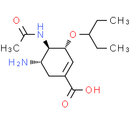Description
Oseltamivir carboxylate is an active metabolite of oseltamivir phosphate (Tamiflu).
Product information
CAS Number: 187227-45-8
Molecular Weight: 284.35
Formula: C14H24N2O4
Synonym:
GS 4071
Ro 64-0802
oseltamivir carboxylate
Chemical Name: (3R,4R,5S)-5-amino-4-acetamido-3-(pentan-3-yloxy)cyclohex-1-ene-1-carboxylic acid
Smiles: CC(=O)N[C@@H]1[C@@H](N)CC(=C[C@H]1OC(CC)CC)C(O)=O
InChiKey: NENPYTRHICXVCS-YNEHKIRRSA-N
InChi: InChI=1S/C14H24N2O4/c1-4-10(5-2)20-12-7-9(14(18)19)6-11(15)13(12)16-8(3)17/h7,10-13H,4-6,15H2,1-3H3,(H,16,17)(H,18,19)/t11-,12+,13+/m0/s1
Technical Data
Appearance: Solid Power
Purity: ≥98% (or refer to the Certificate of Analysis)
Solubility: DMSO: 230 mg/mL (808.86 mM)
Shipping Condition: Shipped under ambient temperature as non-hazardous chemical or refer to Certificate of Analysis
Storage Condition: Dry, dark and -20 oC for 1 year or refer to the Certificate of Analysis.
Shelf Life: ≥12 months if stored properly.
Stock Solution Storage: 0 - 4 oC for 1 month or refer to the Certificate of Analysis.
Drug Formulation: To be determined
HS Tariff Code: 382200
How to use
In Vitro:
GS4071, a potent influenza virus neuraminidase inhibitor, was highly inhibitory to influenza A/NWS/33 (H1N1), A/Victoria/3/75 (H3N2), A/Shangdong/09/93 (H3N2) and B/Hong Kong/5/72 viruses in Madin Darby canine kidney (MDCK) cells. The 50% effective concentrations in these experiments ranged from 1.8 to 59.5 microM, with no cytotoxicity evident at 1000 microM. Influenza B and A/H1N1 viruses were sensitive to oseltamivir (mean B IC50 value: 13 nM; mean H1N1 IC50 value: 1.34 nM). A/H1N2 and A/H3N2 viruses were more sensitive to oseltamivir (mean H3N2 IC50 value: 0.67 nM; mean H1N2 IC50 value: 0.9 nM) .
In Vivo:
The ethyl ester prodrug of GS4071, GS4104, administered by oral gavage (p.o.), had significant inhibitory effects on infections in mice induced by these viruses. No toxicity was seen in dosages up to 100 mg/kg/day. The minimum effective dosage for GS4104 was 0.1 mg/kg/day, with the compound administered twice daily for 5 days beginning 4 h pre-virus exposure. Oral therapy with GS4104 could be delayed from 48 to at least 60 h after exposure of mice to influenza A (H1N1) virus and still render a significant antiviral effect, the time of delay being dependent on the viral challenge dose. Oseltamivir produced a dose-dependent antiviral effect against VN1203/04 in vivo. The 5-day regimen at 10 mg/kg/day protected 50% of mice; deaths in this treatment group were delayed and indicated the replication of residual virus after the completion of treatment. Eight-day regimens improved oseltamivir efficacy, and dosages of 1 and 10 mg/kg/day significantly reduced virus titers in organs and provided 60% and 80% survival rates, respectively.
References:
- Yen HL, et al. Virulence may determine the necessary duration and dosage of oseltamivir treatment for highly pathogenic A/Vietnam/1203/04 influenza virus in mice. J Infect Dis. 2005 Aug 15;192(4):665-72.
- Ferraris O, et al. Sensitivity of influenza viruses to zanamivir and oseltamivir: a study performed on viruses circulating in France prior to the introduction of neuraminidase inhibitors in clinical practice. Antiviral Res. 2005 Oct;68(1):43-8.
- Sidwell RW, et al. Inhibition of influenza virus infections in mice by GS4104, an orally effective influenza virus neuraminidase inhibitor. Antiviral Res. 1998 Feb;37(2):107-20.
Products are for research use only. Not for human use.
Payment & Security
Your payment information is processed securely. We do not store credit card details nor have access to your credit card information.


